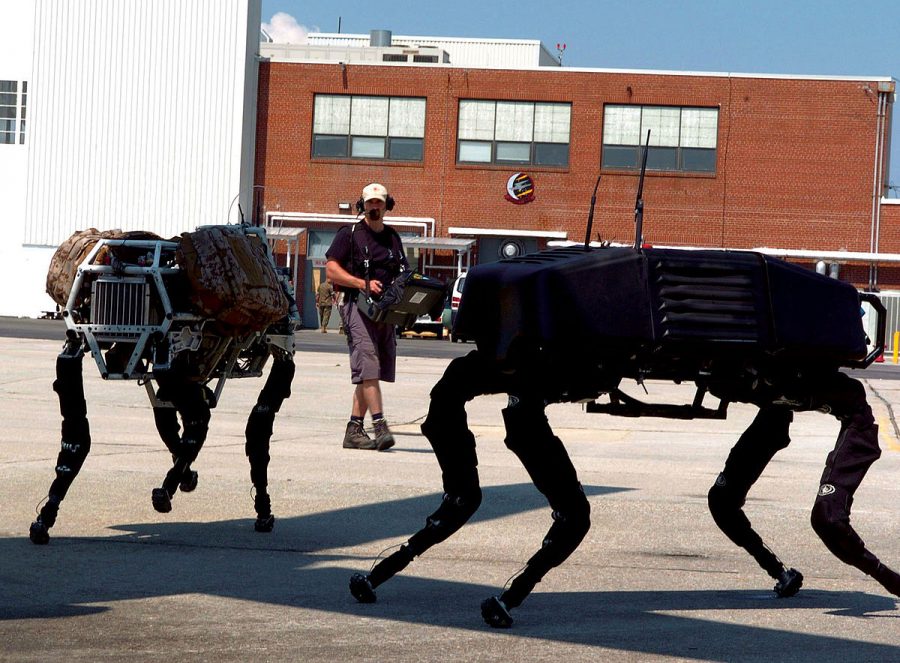Opinion | America needs a plan for artificial intelligence
BigDog robots trot around in the shadow of an MV-22 Osprey while given commands via remote control at Marine Corps Air Station New River, N.C., June 26, 2006.
Apr 25, 2020
From email and texting to GPS services and driver assistance systems, artificial intelligence has already begun to permeate almost every aspect of human life. The time for a robust AI strategy is now. The United States is already far behind China with regards to preparation for the effects of AI, and America must catch up before it becomes impossible.
One of my favorite presidential contenders of this Democratic primary season was Andrew Yang. You know, the “MATH” hat guy. Yang has a knack for public policy, and he seemed eager to try and address the root causes of many of the problems that plague our society, rather than bandage them up with a “fix at a later date” note the way so many of our elected leaders often do.
Yang, much like Senator Elizabeth Warren, had a plan for just about everything. In fact, he released over 150 plans for various issues on his campaign website. One of his most insightful ideas was that the U.S. should establish a new executive department, the Department of Technology.
The first thought that should come to mind after reading that is, “Wait, we don’t have a Department of Technology?”
We sure don’t. The closest thing we currently have in the U.S. is something called the Office of Science and Technology Policy. To give an idea of how truly insignificant that organization is, it has only 45 employees and had no director for the first 19 months of Trump’s presidency. That’s not surprising, given Trump’s open contempt for science.
Get The Daily Illini in your inbox!
We need a real technology department, one that can make progress on many issues simultaneously and that gives special focus to our greatest technological challenge, artificial intelligence.
According to Amy Webb, futurist and author of “The Big Nine: How the Tech Titans and Their Thinking Machines Could Warp Humanity,” when most people think of AI, they wrongly think of something inherently negative and anthropomorphized. That is, they think of AI as a kind of evil super-intelligent humanoid — think Terminator or Ultron.
But this is not what AI is in reality. Modern society is already drowning in artificial intelligence. Apple’s Siri, Amazon’s Alexa and Google’s Assistant, as well as our internet browsers, email accounts, messaging services and social media platforms all employ AI to nudge us in certain directions, such as with suggested words or increased organization.
However, all of these features are relatively early versions of what is known as “narrow” artificial intelligence (ANI) — machine intelligence that excels only at one task. We already have AI that can play chess or Go better than any human ever could.
In the not too distant future, Webb argues, researchers will almost certainly create what is known as “general” artificial intelligence (AGI) — machines that can perform any task the way a human could. And, because most of the algorithms at the heart of this AGI will be written to allow for self-improvement, AGI could eventually evolve into artificial superintelligence (ASI). ASI would almost certainly end up being orders of magnitude more intelligent than the smartest human who has ever lived or than every human combined.
See where that could become an issue?
Your mind is probably now filled with nightmare scenarios of what could happen if someone were to use AGI or ASI for wicked purposes, or if this technology became impossible for humans to control at all. Remember HAL 9000 from “2001: A Space Odyssey?” Either scenario could easily pose an existential risk to humanity in the not too distant future.
China, unlike the U.S., has a clear and broad strategy regarding artificial intelligence. In 2017, China launched its “New Generation Artificial Intelligence Development Plan,” (AIDP) in which it aims to be the world leader on AI by 2030. What’s most concerning is the rate at which the U.S. is being outspent on research and other investments regarding the future of machine learning technology. China is spending billions, while many elected officials in the United States don’t even understand how Facebook works.
This is why the United States needs a coherent, unified national strategy when it comes to all technology development, especially artificial intelligence. The possibility of being surpassed on AI capability by China, having machine intelligence cause an existential risk to humanity or both are all reasons why the U.S. government needs to get its ducks in a row.
Experts have already outlined what a strategy for tech and artificial intelligence should look like. The United States must implement such a strategy before it becomes too late, and the clock is ticking.
Clint is a junior in LAS.






